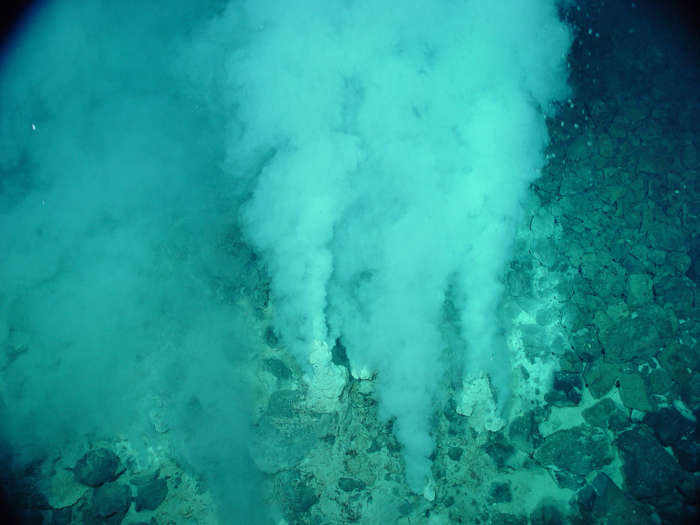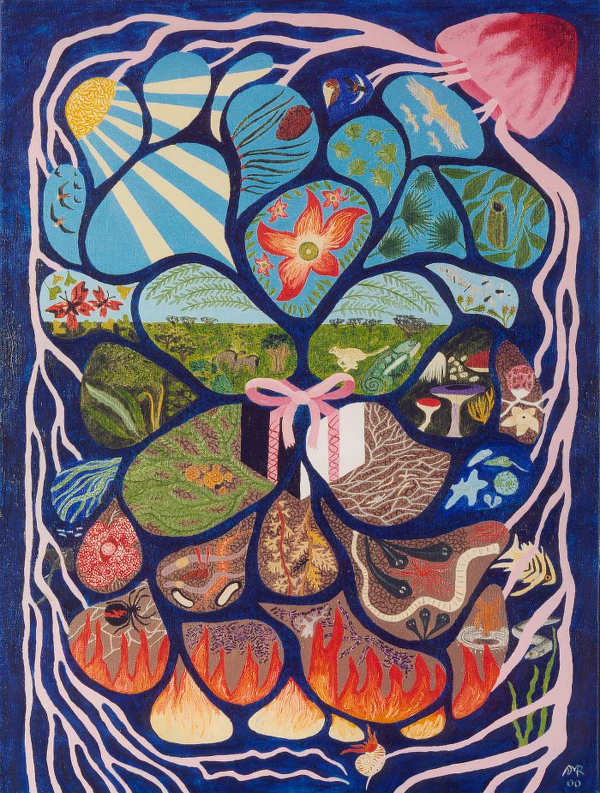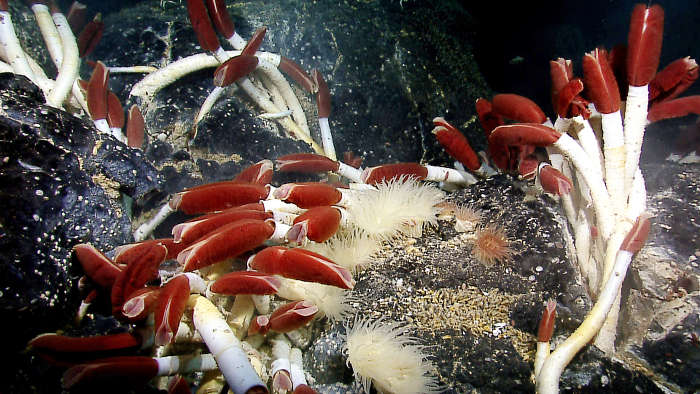By Doug Marman and Alan Rayner
(This article has also been published on BestThinking.com: https://www.bestthinking.com/articles/science/biology_and_nature/genetics_and_molecular_biology/how-can-anything-be-half-alive-)
A new understanding of biology shows that life originates in a community and that individuality evolves when beings work together.

Cells that spawned all of life on our planet appear to have lived in hydrothermal vents. Image courtesy of NOAA.
Recently, we published a paper showing a new way of looking at the foundation of life: as a relationship between a lifeform and its habitat. If we use this lens, the origin of life suddenly makes a lot more sense.
Now here comes a new study that’s been reported in The NY Times, Smithsonian.com, The Christian Science Monitor, Independent and others, that identifies the genetic makeup of the cells from which all life on this planet descended. These mother cells are called the “Last Universal Common Ancestor” (LUCA). But the microbiologists who reported this news went on to say that it appears as if LUCA was only “half-alive.” How can anything be half-alive?
The scientists made this claim for a reason, because they see DNA as a building block of life. You see, a cell’s structure and function is dependent on proteins, and the genes in DNA guide the manufacturing of proteins. This allows a cell to build its own body. But LUCA was missing the genes needed to create crucial proteins. In other words, its genome was incomplete. So it appears that LUCA was dependent on its surroundings to supply the necessary materials.
Does this mean it was half-alive? No. All living things depend on their neighborhood, as we showed in our previous article. No lifeform is an island because life doesn’t belong to it alone. Living is a relationship—a continual give-and-take—between organisms and other living creatures in the world around them. This is why their bodies are porous and fluid. The expressions of other life forms nourish us, and the wastes and breaths we expel are food for others. Being alive is a shared experience.
The problem is that we don’t have a scientific explanation for what living is. And since we don’t understand how it works, we revert to old lenses. This is why many who study the origin of life look for cause-and-effect reactions learned from physics and chemistry, even though it’s clear that this approach falls short. Using the wrong lens, unfortunately, can also distort the picture.
Saying that LUCA was half-alive makes no sense. It’s like saying a woman with an unfertilized egg cell is half-pregnant and she becomes fully pregnant only when she gets the necessary ingredients from a sperm cell. That’s ridiculous. There is no such thing as being half-pregnant. There is no such thing as being half-alive. And there is no such thing as independent living because all creatures depend on others to thrive.
Complete independence would only be possible if a creature, by itself, created everything it needed to be alive. That’s impossible. Why? Because living means gathering and using energy, and nothing can create all of the energy it needs, by itself.
Where does energy come from? For life on Earth, our sun is the main source, but long ago the heat within our planet was also an important element. The molten core created deep sea ‘hydrothermal vents,’ and this is where LUCA appears to have survived.
However, this doesn’t tell us fundamentally where energy originates. To understand this, we can’t use the traditional physics that we learned from Isaac Newton, where external forces move lifeless matter. Instead, we must turn to quantum mechanics, which shows us that what physicists call ‘forces’ emerge from invisible, shared exchanges between ‘particles’.
Different types of relationships between particles lead to different types of energy.[1] For example, electricity and magnetism are the result of particles forming mutual one-on-one relationships with each other. Organisms display the same trait. Even we, as human beings, feel the power of attraction and repulsion when meeting people. We call it ‘chemistry’.
A second type of relationship leads to an attraction that pulls groups of particles to work together. The bodies of protons and neutrons are formed this way, when three quarks begin spinning as a unified group. And the bodies of atoms are held together by the attraction that emerges from the protons and neutrons that form the nucleus. Physicists call this the strong force. The same unification occurs with living things. We experience the added energy when people work together as a community. And the camaraderie we feel with co-workers is the same feeling of inclusiveness that pulls cells together to work as a body. This is why we see a relationship between living things and their habitats at the heart of every ecosystem.
Therefore, life is expressed through relationships.
This insight paints an inspiring new picture of how the first cells came into existence. There was never a time when ‘lone wolf’ bacteria lived in an empty, inert world because the world we live in is just as much alive with energy as we are. Our desire to live emerges from our relationships with a living environment. This means that the process of evolution is not something that happens to individuals—it is the community and their relationships that evolve.
Imagine being the only person in the world. You have no friends, family, or anyone to talk to. Would you ever want to develop a new business? Would you feel the need to learn how to read or write? Does it matter how much money you have?
Now think about what you look forward to when waking up in the morning. Isn’t your involvement with other living beings most important? Relationships are the medium of life.
Once we see that this is the essence of living, we have a new lens that reveals deeper truths behind the story of life.
For example, it helps us understand how life developed before genes existed. As we showed in our previous article, if you remove DNA from a cell, the cell will continue living for a while. It can’t reproduce, and it can’t replace or repair proteins, but it’s still alive. This proves that genes aren’t necessary for life to exist.
On the other hand, if you take DNA out of a cell—its habitat and home—it becomes a mere chemical compound. It doesn’t do anything special. In other words, DNA comes into life when it’s in the right ecosystem. If this is true, then this applies to all of the enzymes and proteins in a cell. That is why they respond to each other and the cell itself. They’re dynamic inhabitants of each other’s neighborhood and the shared space of the cell.
Where does the magic come from that pulls these molecules and atoms together to form a living organism? More than chemical actions and reactions are needed. A mutually inclusive relationship is required. This ‘quantum state’ is why cells work so closely together that they form our human bodies. It’s a natural phenomenon that emerges from group relationships when beings work for a common good.
According to quantum theory, these relationships can’t be explained by their individual components because they’re shared. When quantum particles become ‘entangled,’ an added dynamic exists between them that keeps them allied. This is why dissecting organisms will never show us how life works, because the shared exchanges in relationships are hidden from outsider eyes. Only those involved can feel the fluid cohesion aligning them.
We aren’t the source of our own life. We need oxygen, carbohydrates, fats, and proteins, all supplied primarily by photosynthetic bacteria and plants, in meat, fruit, and vegetables. Other life forms die for us to live, just as the death of our bodies is food for other organisms. How could human beings ever evolve if these other life forms didn’t evolve first?
Biologists are right to say that the first proto-cells—the cells that were not yet able to fashion all the proteins they needed to make their bodies—were dependent on the world around them. If a hydrothermal vent was the source, they were tethered to that vent. They weren’t free to roam elsewhere. Therefore, life was restricted before the necessary genes developed. But this doesn’t mean these proto-cells were half-alive. We have more mobility as human beings today, but we’re just as reliant on our ecosystem. We’ve simply replaced our dependence on a static source of power and materials for dependence on a dynamic neighborhood of cellular life.
This leads us to a question that has stumped biologists: What gave rise to life before cells began to reproduce? In other words, why did living things start creating progeny in the first place? If being alive is the only objective, then why would proto-cells give birth to children? It didn’t help them persist as individuals. In fact, reproduction is an energy-demanding process that requires life forms to expose themselves to risk rather than seal themselves off from the outside world.
Biologists often turn to Darwinism to explain the mysteries of biological life, but this can’t explain what happened before reproduction began and genes existed. Darwin’s theories offer no help in understanding the meaning of life.
But if we accept that life is a relationship between living things and their habitat, then we can see what’s missing from the puzzle: Reproduction develops stronger communities. Remember, proto-cells couldn’t survive on their own. They weren’t foolish enough to believe that they lived independently. They belonged within their neighborhood, like a tree is rooted within the earth.
In other words, they didn’t struggle to preserve their individual lives. They were participating in a shared adventure with others. That is the story of the origin of biological life on Earth.
No wonder they risked their lives and spent their hard-won energy and resources to produce offspring, because this was the only way they could sustain and build the community they were living in. Helping their community helped them blossom as well, strengthening the mutual relationship
Think of human experiences. Do you feel better when you lie, steal, and think only of your own desires? Or do you feel more empowered and healthier when contributing to a purpose larger than yourself? Psychologists have shown that working for families, friends, communities, and companies leads to psychological growth and maturity. Selfish individuals actually de-evolve. They regress psychologically.[2]
Biologists see the same thing. Parasites devolve. They lose genes over time, making them more and more dependent on their hosts.[3] Their lives get smaller. That’s the outcome of selfish living.
This all makes sense if living is a relationship between an organism and its habitat. The source of a creature’s life is the community it lives in, even for humans that are free to move around the planet. The more we work to make a healthier ecosystem—to enrich the world—the more we feel life-energy flowing through us. The reason is because energy flows through mutually inclusive relationships.
Therefore, the origin of cellular life needed more than a source of energy. It also required a place where communities of mutually dependent proto-cells could survive for long periods of time. Yes, they needed the right chemical elements, but they also needed other partial life forms, and they needed millions of years. Only then, as they co-evolved their community, could they start making the genes that would one day allow them to roam freely and spread across the globe. Stronger communities, working together, produced genes that would eventually give cells the freedom and ability to roam.
This reveals a fascinating insight: Individuality evolves when beings work together.

Hydrothermal vents create millions of tiny spaces just right for proto-cells. Reproduced with permission from Deborah S. Kelley and the Oceanography Society (Oceanography, Dec. 2007).
It turns out that deep sea hydrothermal vents were perfect environments for the origin of biological life, because they create millions of small cavities, just right for proto-cells to inhabit. Each cavity was a room with a built-in energy supply, as the warm chemistry flowed through it from the molten core. More importantly, the environment could protect a growing community of genetically incomplete cells. And these vents existed for millions of years.
So the process of life began long before LUCA. Communities grew and evolved gradually over millions of years before giving birth to organisms with mobility. Cellular life then eventually found a way of making their homes in virtually every nook and cranny, from the driest to wettest and coldest to hottest places on the planet.
The simplest expressions of living are in communities. This is and always has been the heart of life. This is why we grow as individuals when we work for the world we live in. We need our habitat and our habitat needs us. It’s a shared relationship—a quantum condition that is invisible to outside observers. We must be involved in this mutual exchange of life or we can’t live in this world. That’s why there is no such thing as being half-alive.
[1] Doug Marman, Lenses of Perception: A Surprising New Look at the Origin of Life, the Laws of Nature, and Our Universe (Washington: Lenses of Perception Press, 2016), p. 242-258.
[2] http://www.ncbi.nlm.nih.gov/pmc/articles/PMC2743415/pdf/nihms115884.pdf
[3] Marman, Lenses of Perception, p. 376-378.



The more this is developed, the more I can see myself accustomed to this new lens. It is so interesting, this way I can no longer look at these batteries, cells and all those small particles as before; this new lens gives a whole new meaning to them that I regret missing it in the past. This brings a whole new meaning to life.
Beautifully expanding topics introduced in the book. What a treat also to have been introduced to Dr. Rayner’s work and beautiful (and whimsical) paintings.